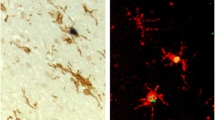Abstract
Human post-mortem brain tissue, mostly provided by brain banks, is precious because most human neurodegenerative diseases are restricted in their complete forms to human beings. However, the agonal state, post-mortem delay between death and tissue processing, variable vulnerability of chromatin, RNAs, proteins and metabolites can compromise the usability of the tissue material. Such factors must be considered and assessed in every experimental approach. The use of controls for comparative purposes to analyze diseased cases is crucial as the basic conditions of controls must be the same as those encountered in problem cases. Age, gender, region, hemisphere, and clear characterisation of objective neuropathological changes (e.g., Alzheimer’s disease stages of Braak and Braak) in matching controls and problem cases must be considered in every study, and data must be clearly specified when presenting materials and methods in publications. Additional care must be taken regarding atypical neurodegenerative alterations, concomitant pathologies, and systemic diseases, together with drug consumption and treatments. The absence of neurological and mental symptoms and signs, although a sine qua non condition, is not sufficient to match control and problem cases for research.
Similar content being viewed by others
References
Azzi A, Dallmann R, Casserly A, Rehrauer H, Patrignani A, Maier B, Kramer A, Brown SA (2014) Circadian behavior is light-reprogrammed by plastic DNA methylation. Nat Neurosci 17:377–382
Barrachina M, Moreno J, Villar-Menendez I, Juves S, Ferrer I (2012) Histone tail acetylation in brain occurs in an unpredictable manner after death. Cell Tissue Bank 13:597–606
Bossers K, Wirz KTS, Meerhoff GF, Essing AHW, van Dongen JW, Houba P, Kruse CG, Varhaagen J, Swaab DF (2010) Concerted changes in transcripts in the pre-frontal cortex precede neuropathology in Alzheimer’s disease. Brain 133:3699–3723
Cantuti-Castelvetri I, Keller-McGandy C, Bouzou B, Asteris G, Clark TW, Frosch MP, Standaert DG (2007) Effects of gender on nigral gene expression and Parkinson disease. Neurobiol Dis 26:606–614
Crecelius A, Götz A, Arzberger T, Fröhlich T, Arnold GJ, Ferrer IA, Götz A, Arzberger T, Frölich T, Arnold GJ, Ferrer I, Kretzschmar H (2008) Assessing quantitative post-mortem changes in the grey white matter of the human frontal cortex proteome by 2D-DIGE. Proteomics 8:1276–1291
Durrenberger PF, Fernando S, Kashefi SN, Ferrer I, Hauw JJ, Seilhean D, Smith C, Walker R, Al-Sarraj S, Troakes C, Palkovits M, Kasztner M, Huitinga I, Arzberger T, Dexter DT, Kretzschmar H, Reynolds R (2010) Effects of antemortem and postmortem variables on human brain mRNA quality: a BrainNet Europe study. J Neuropathol Exp Neurol 69:70–81
Ferrer I (2012) Defining Alzheimer as a common age-related neurodegenerative process not inevitably leading to dementia. Prog Neurobiol 97:38–51
Ferrer I (2014) Brain Banking. In: Aminoff MJ, Daroff RB (eds) Encyclopedia of the Neurological Sciences, vol 1, 2nd edn. Academic Press, Oxford, pp 467–473
Ferrer I, Santpere G, Arzberger T, Bell J, Blanco R, Boluda S, Budka H, Carmona M, Giaccone G, Krebs B, Limido L, Parchi P, Puig B, Strammiello R, Strobel T, Kretzschmar H (2007) Brain protein preservation largely depends on the postmortem storage temperature: implications for study of proteins in human neurologic diseases and management of brain banks: a BrainNet Europe Study. J Neuropathol Exp Neurol 66:35–46
Ferrer I, Martinez A, Boluda S, Parchi P, Barrachina M (2008) Brain banks: benefits, limitations and cautions concerning the use of post-mortem brain tissue for molecular studies. Cell Tissue Bank 9:181–194
Kovacs GG, Alafuzoff I, Al-Sarraj S, Arzberger T, Bogdanovic N, Capellari S, Ferrer I, Gelpi E, Kövari V, Kretzschmar H, Nagy Z, Parchi P, Seilhean D, Soininen H, Troakes C, Budka H (2008) Mixed brain pathologies in dementia: the BrainNet Europe consortium experience. Dement Geriatr Cogn Disord 26:343–350
Kretzschmar H (2009) Brain banking: opportunities, challenges and meaning for the future. Nat Rev Neurosci 10:70–78
Li JZ, Vawter MP, Walsh DM, Tomita H, Evans SJ, Choudary PV, Lopez JF, Avelar A, Shokoohi V, Chung T, Mesarwi O, Jones EG, Watson SJ, Akil H, Bunney WE Jr, Myers RM (2004) Systematic changes in gene expression in post-mortem human brains associated with tissue pH and terminal medical conditions. Hum Mol Genet 13:609–616
Monoranu CM, Grünblatt E, Bartl J, Meyer A, Apfelbacher M, Keller D, Michel TM, Al-Saraj S, Schmitt A, Falkai P, Roggendorf W, Deckert J, Ferrer I, Riederer P (2011) Methyl- and acetyltransferases are stable epigenetic markers postmortem. Cell Tissue Bank 12:289–297
Murphy DD, Ravina B (2003) Brain banking for neurodegenerative diseases. Curr Opin Neurol 16:459–463
Preece P, Cairns NJ (2003) Quantifying mRNA in post-mortem human brain: influence of gender, age at death, postmortem interval, brain pH, agonal state and inter-lobe mRNA variance. Brain Res Mol Brain Res 118:60–71
Samarasekera N, Al-Shahi Salman R, Huitinga I, Klioueva N, McLean CA, Kretzschmar H, Smith C, Ironside JW (2013) Brain banking for neurological disorders. Lancet Neurol 12:1096–1105
Tomita H, Vawter MP, Walsh DM, Evans SJ, Choudary PV, Li J, Overman KM, Atz ME, Myers RM, Jones EG, Watson SJ, Akil H, Bunney WE Jr (2004) Effect of agonal and post-mortem factors on gene expression profile: quality control in microarray analyses of post-mortem human brain. Biol Psychiatry 55:346–352
Webster MJ (2006) Tissue preparation and banking. Prog Brain Res 158:3–14
Acknowledgments
This paper is the result of fruitful collaboration within the context of BrainNet Europe (European Commission, 6th Framework Program Life Science: LSHM-CT-2004-503039). Thanks to T. Yohannan for editorial assistance.
Author information
Authors and Affiliations
Corresponding author
Rights and permissions
About this article
Cite this article
Ferrer, I. Selection of controls in the study of human neurodegenerative diseases in old age. J Neural Transm 122, 941–947 (2015). https://doi.org/10.1007/s00702-014-1287-y
Received:
Accepted:
Published:
Issue Date:
DOI: https://doi.org/10.1007/s00702-014-1287-y




